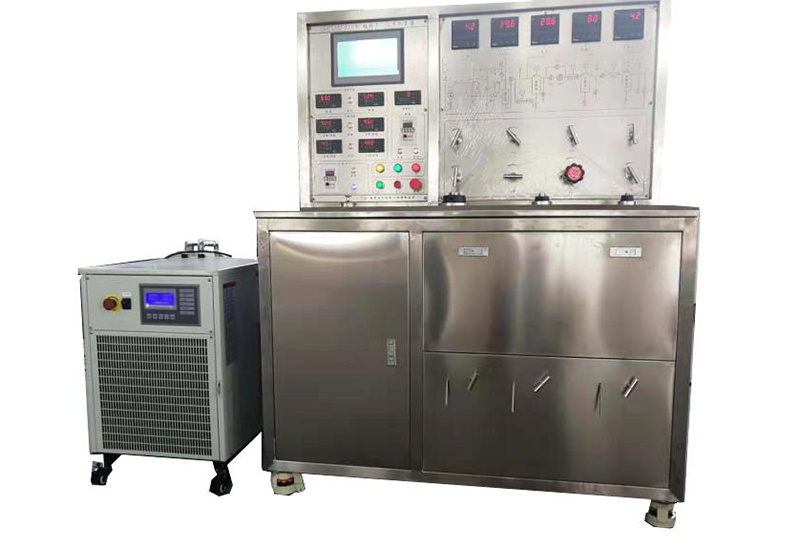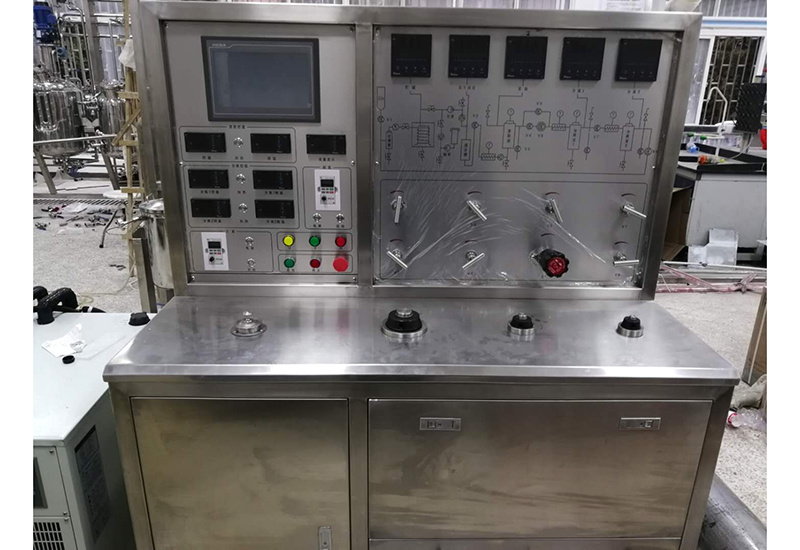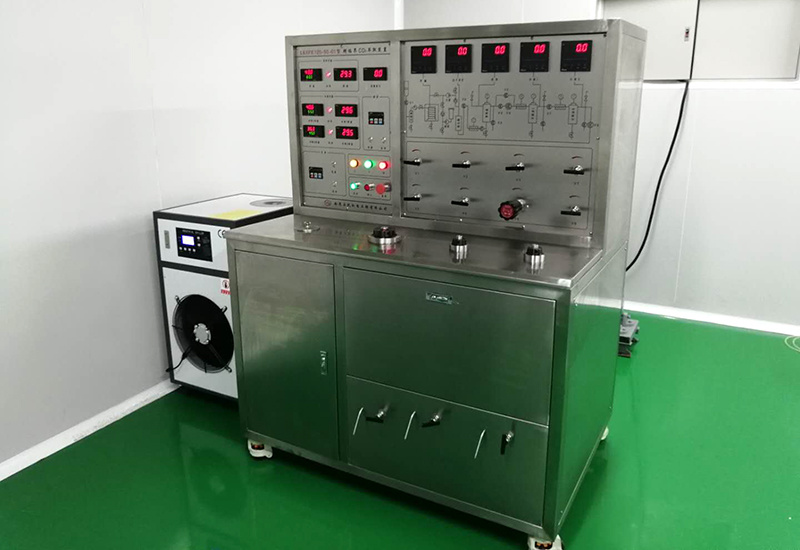Nantong Likai Electromechanical Engineering Co., Ltd.
Contact Us
Mobile: 86-13773689955
Mailbox: ntlkjd@126.com
Address: No. 198, Changjiang West Road, Hai'an County, Nantong City, Jiangsu Province
Aerogel supercritical drying device (200L)
Supercritical carbon dioxide extraction technology is a subject in modern chemical separation, and it is a separation process that has emerged in the world.
- Commodity name: Aerogel supercritical drying device (200L)
Key words:
Supercritical drying device丨Supercritical extraction device
- Product Introduction
-
Aerogel Overview:
Aerogel is a porous nanomaterial with a high specific surface area and a low bulk density. Because aerogel has a unique nanostructure, it has broad application prospects in aerospace, catalysis, environmental protection and other fields, and its preparation technology has become an emerging field of chemical engineering research. Sol-gel method is a common method for preparing aerogel, which includes three processes of sol preparation, gel preparation and gel drying.
The drying process of the gel is an important process. Conventional drying methods have the following adverse effects on the preparation of aerogels: the base particles of the material become coarser, the specific surface area is greatly reduced, and the pores are greatly reduced. Supercritical fluid drying (SCFD) developed in recent years does not have such adverse effects.
Since the supercritical fluid has both gas and liquid properties, there is no gas-liquid interface, and therefore no surface tension exists. At this time, there is no additional pressure generated by the surface tension in the gel capillary hole. Therefore, by using the supercritical fluid to dry the gel, the gel structure collapse caused by the additional pressure is not generated, the shrinkage of the gel during the drying process is avoided, and the gel network frame structure is maintained. Ultrafine aerogel with high specific surface area, uniform particle size distribution and large pore volume.
Ways to achieve gel drying:
There are two main types of drying media commonly used: one is organic alcohols such as methanol and ethanol; and the other is CO2.
The existing SCFD technology can be divided into the following three categories:
2-1, high temperature supercritical organic solvent drying:
The catalyst prepared by the sol-gel method is generally carried out in an aqueous solution. Since the critical temperature and critical pressure of water are relatively large (Tc=374.15 °C, Pc=22.12 MPa), the hydrogel is not suitable for direct supercritical fluid drying.
The high-temperature supercritical organic solvent drying method is to displace the hydrosol obtained by the reaction with an organic solvent to obtain an organosol or directly obtain an organosol by other methods, and the organosol is aging to become an organic gel; The glue is placed in a high-pressure dryer which has been placed in an appropriate amount of the same solvent, and the temperature is increased to bring the organic solvent to a supercritical state, and the supercritical property of the organic solvent is utilized to achieve the purpose of repelling the solvent in the gel.
The high-temperature supercritical organic solvent drying method is simple in operation and has obvious drying effect. After the hydrogel is prepared, the alcohol sol is obtained by exchange with absolute ethanol, the alcohol gel is obtained by aging, and the ethanol is used as the medium to dry the alcohol by SCFD method. gel.
2-2, liquid CO2 replacement supercritical drying:
The critical temperature of CO2 is close to room temperature, and CO2 is non-toxic, non-flammable and explosive. Therefore, CO2 must be a good drying medium for supercritical fluid drying. The liquid CO2 replacement supercritical drying method uses supercritical drying of CO2 instead of organic solvent as a drying medium.
The method firstly replaces the liquid solvent in the gel with liquid CO2, and then pressurizes and pressurizes to make the CO2 reach a supercritical state, and finally uses the supercritical property of CO2 to perform aerogel drying. Since the drying process has a relatively low temperature, this method is also called a low temperature supercritical CO2 drying method.
Taking alcohol gel drying as an example, the alcohol gel is placed in a supercritical drier and liquid CO2 is introduced for solvent replacement to remove water and ethanol in the alcohol gel, and then the temperature is supercharged and pressurized to achieve supercritical carbon dioxide. Conditions, after a certain period of time, the carbon dioxide gas is slowly released, and finally an aerogel solid is obtained.
2-3, supercritical CO2 extraction and drying:
Because liquid CO2 replaces the solvent for a long time and the drying cycle is too long, which is not suitable for industrial production, it is gradually replaced by supercritical CO2 extraction and drying method. The supercritical CO2 extraction drying method is a combination of supercritical extraction technology and supercritical fluid drying technology. Compared with the liquid CO2 displacement supercritical drying method, the step of removing the solvent by liquid CO2 is omitted, and the alcohol gel micro-extraction is directly extracted by supercritical CO2. The alcohol in the pores allows the gel to be dried while substantially maintaining the original structure, so that the entire drying time is further shortened and the operating cost is greatly reduced.
Main factors of aerogel drying:
Compared with the sol-gel process, the supercritical fluid drying process involves more complex systems and more process conditions, and many of the process conditions of the supercritical fluid drying process will have a greater impact on the structure and performance of the final aerogel. influences. Therefore, the correct selection of these process conditions is critical to the preparation of high performance aerogels.
The process conditions mainly include: drying medium type, medium flow rate, drying time, drying temperature, drying pressure and the like.
3-1, the impact of drying media:
After the TiO2 aerogel was prepared, the TiO2 alcohol gel was dried by using supercritical ethanol and supercritical CO2 as drying medium. The drying conditions for controlling supercritical ethanol are: T=270°C, P=8Mpa, constant temperature time is 0.5h; the drying condition of supercritical CO2 is: replacement time of liquid CO2 replacing ethanol t=72h, T=42°C, P= 9.0Mpa, drying and constant temperature for 5h. The TiO2 aerogel obtained from different drying media was compared by photocatalytic degradation of rhodamine B. The experimental results show that the photocatalytic activity of TiO2 aerogel obtained by using CO2 as drying medium is better than that obtained by using ethanol as drying medium. gum.
Because the drying temperature of the CO2 drying method is low, the process is free of inflammable and explosive gases, and the prepared aerogel particles do not contain carbon, the SCFD technology using CO2 as a drying medium is easier to industrialize.
3-2. Impact of media flow:
ZrO2 aerogels were designed to investigate the effects of CO2 flow and other factors on the preparation of ZrO2 aerogels by orthogonal design. The four-factor and three-level orthogonal experimental conditions were: CO2 flow rate was 0.42L/h, 0.65L/h, 0.90L/h; drying pressure was 8.6MPa, 9.0MPa, 9.5MPa; drying time was 5h, 6h, 7h; The drying temperature was 40 ° C, 50 ° C, and 60 ° C.
The optimal drying conditions obtained by orthogonal experiment are: CO2 flow rate 0.65L/h, drying pressure 9.5MPa, drying time 6h, drying temperature 50°C. This means that the flow rate of the drying medium and the drying effect are not in a simple linear relationship, but there is an optimum value. On the one hand, as the CO2 flow rate increases, the mass transfer driving force between the dispersion medium ethanol and the supercritical CO2 fluid increases, and the extraction drying speed increases; on the other hand, if the CO2 flow rate is too large, the condensation is obtained. The rate of ethanol extraction on the surface of the gel is too fast, and a large ethanol concentration gradient is formed between the gel pores, which causes an increase in the diffusion rate of ethanol between the pores, affecting the internal structure of the gel and causing more cracks. Not conducive to the formation of high specific surface area aerogel.
3-3. Effect of drying time:
The SiO2 alcohol gel was placed in a high-pressure extraction autoclave of CO2 supercritical extraction and dried, and subjected to extraction and drying by CO2 under supercritical conditions. The supercritical conditions were as follows: pressure P=10MPa, temperature T=40°C, flow rate 10kg/min, extraction and drying for 5h, 10h, 20h respectively. It was found that the specific surface area of SiO2 aerogel obtained by different drying time was different. It is 574 m 2 /g, 583 m 2 /g, and 603 m 2 /g.
This indicates that the longer the extraction time, the larger the specific surface area of the obtained aerogel. However, considering the comprehensive economic benefits, the drying time should be selected.
3-4, the effect of drying pressure:
Under the condition of ensuring the supercritical fluid is reached, the specific surface area of the oxide aerogel decreases as the supercritical drying pressure increases. This is because as the drying pressure increases, the fluid density increases, the mass transfer resistance increases, causing a decrease in the mass transfer rate and a decrease in the aerogel specific surface area. Of course, if the pressure does not reach the supercritical condition, the solvent's solubility will be greatly reduced, and surface tension will be generated between the solid particles. When the solvent is removed, the gel structure is easily destroyed, resulting in a decrease in surface area and pore volume. Therefore, the optimum drying pressure should be chosen to be slightly above the critical pressure of the medium.
3-5, the effect of drying temperature:
MnO2 aerogel, the gel was dried by SCFD technology. The drying reaction time was 2h in the drying process and the supercritical drying pressure was 6.6MPa. By changing the supercritical drying temperature, the results showed that with the supercritical drying temperature rising High, the specific surface area of the aerogel powder gradually increases, reaching a maximum at 263 ° C; then, with increasing temperature, the specific surface area is gradually reduced.
This shows that under supercritical conditions, temperature has two effects: on the one hand, the higher the temperature, the smaller the density of the medium fluid, the greater the mass transfer driving force, which is conducive to water repelling and improves the surface area of the aerogel: On the other hand, the higher the temperature, the easier the particles grow under the action of hydrothermal, and the surface area of the aerogel decreases. To this end, we should reasonably choose an optimal temperature based on the trend of these two aspects.
Supercritical drying device consists of:
The supercritical drying device mainly comprises: a gas source system, a refrigeration system, a flow control system, a temperature control system, a pressure control adjustment system, a drying device, an electrical control of the separation device, and a bracket box.
Supercritical carbon dioxide extraction technology is a subject in modern chemical separation, and it is a separation process that has emerged in the world. All supercritical fluids refer to fluids whose human mechanical state is above the critical point (Pc, Tc). The critical point is the state point where the gas-liquid interface has just disappeared. Supercritical fluids have very unique physical and mechanical properties. Its density is close to jade liquid, its viscosity is close to gas, and its diffusion coefficient, viscosity is small, dielectric constant and other characteristics make its separation effect better and it is a good solvent. Supercritical extraction means that under high pressure and under appropriate turbulence, the solvent is contacted with the extract in the extraction cylinder, the solute is diffused into the solvent, and then the operating conditions are changed in the separator to separate the dissolved substances. The equipment is widely used in biological, pharmaceutical, food and other fields.
Key words:
Consultation
Note: Please leave your email and our professionals will contact you as soon as possible!
Nantong Likai Electromechanical Engineering Co., Ltd.
Product Service Hotline:
Address:
No. 198, Changjiang West Road, Hai'an County, Nantong City, Jiangsu Province

Scan Access Mobile Edition
Copyright © 2024 Nantong Likai Electromechanical Engineering Co., Ltd.
Powered by 300.cn | SEO Tags | Business License




